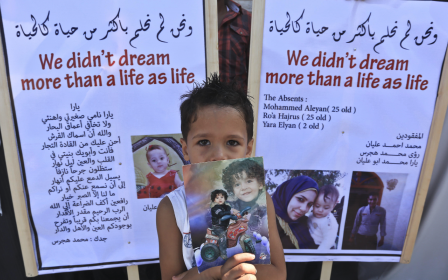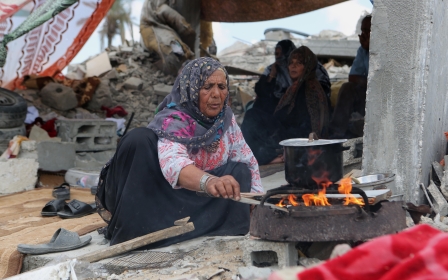Local rights groups still documenting toll of Israel's Gaza offensive

Nearly a month after an Israeli military offensive against the Gaza Strip, Palestinian human rights organisations continue to collect and process documentation from 51 days of attacks on the coastal enclave.
During the operation, which ended with an indefinite ceasefire on 26 August, several of the larger groups pooled their efforts, sharing staff and information to cope with the challenges of a spike in incidents and casualties.
Other specialised organisations operated independently, persevering through the many dangers facing their staff and significant obstacles to their work.
Khalil Shaheen, director of the social and economic rights unit at the Palestinian Centre for Human Rights (PCHR), said his organisation’s cooperation with three others had increased their efficiency.
“The impact of this coordination produced a new model,” he said. “Field workers from two organisations, PCHR and Al-Mezan, worked together. They shared their documents and compiled information.”
“We distributed the responsibilities for field work. PCHR became responsible for collecting data and questionnaires for killed and injured people from the middle and southern areas. Al-Mezan was responsible for the Gaza and North Gaza governorates.”
Meanwhile, he said, his unit documented the conditions facing an estimated 500,000 displaced by threats and attacks on their homes and neighbourhoods.
PCHR, the largest human rights group in the Gaza Strip, has 55 permanent workers and hired another 30 during the offensive. The Al-Mezan Centre for Human Rights normally employs 30, its executive director, Issam Younis, said, but likewise expanded.
Two other organisations with smaller staffs, Gaza’s Al-Dameer Association for Human Rights and Al-Haq, based in the West Bank, also joined the effort.
“Field workers in both al-Haq and al-Dameer were involved in the process,” Shaheen said. “But they worked within the coalition, under the supervision of PCHR and al-Mezan.”
“It wasn’t strange that during the 51 days, directors of both al-Mezan and al-Dameer were based here at PCHR’s office,” he added.
Under normal circumstances, Palestinian human rights groups monitor sporadic Israeli aggression; gunfire at farmers in their fields, naval attacks on fishermen at sea, detentions of Palestinians attempting to travel for study or medical treatment, and occasional airstrikes.
Through this documentation, the organisations prepare both legal files for future litigation and informational materials for public distribution.
The groups’ capacities, sufficient to meet this workload, were stretched to the limit by thousands of bombings, shootings and incursions over the offensive.
“The kinds of war crimes we are faced with are unprecedented, in quantity and quality,” Younis said.
“Every single figure has a name. You have to go there, speak with the family, and verify the list of statistics. It’s an ongoing process.”
Down the hall from his office in al-Mezan’s building, half a dozen young Palestinians sat in a computer lab, entering information gathered by field workers.
The reports came from both al-Mezan’s investigators and those of the other three groups, Younis said.
“From the first day of the aggression, the four human rights organisations that have a field presence here in Gaza formed one team. For documentation, about 100 field workers were deployed.”
As bombs rained on the Gaza Strip from air, land and sea, groups faced challenges not only to their capacity, but also their staff’s ability to access affected areas.
“We couldn’t immediately reach all of the cases, so we had to contact the families by phone,” Mohammad Abu Rukbeh said. “During ceasefires, we would go cover cases we hadn’t been able to reach by phone during attacks.”
Abu Rukbeh, senior field worker in the Gaza Strip for the West Bank-based group, Defence for Children International – Palestine, leads a local team of five field researchers and two volunteers.
Because of its specialised role in documenting violence against children, the group worked outside the coalition established by four others.
“We had difficulty moving,” Abu Rukbeh said. “There was little transportation, and going anywhere was insecure. We couldn’t easily recognise targeted houses that included children.”
Still, he said, his staff performed critical work, including a case he documented of Israeli soldiers forcing 17-year-old Ahmad Abu Raida to act as a human shield over five days as their hostage.
Many human rights workers faced risks to even reach their offices, Younis said.
“It was very dangerous. Some had to come from Khan Younis, or Rafah. Even in Gaza, movement was very difficult.”
Due to their many challenges, groups reoriented existing resources to the immediate tasks at hand, Shaheen said.
“All the training programmes were stopped. We were most concerned with achieving comprehensive reports, documentation and media analysis of the offensive.”
“All of PCHR and other human rights organisations’ staff became field workers,” Shaheen added. “The women’s affairs and legal units didn’t work do their normal work of delivering legal aid and counselling, because all types of life, for example the courts, were totally stopped.”
Like countless others across the Gaza Strip, human rights workers suffered personal losses, as well as professional challenges, during the offensive.
Shaheen was forced to evacuate his house and temporarily relocate to his daughter’s home near Al-Shifa hospital. Then, he said, “A car was targeted in front of her house, so we were evacuated again.”
Similarly, ten of Abu Rubkeh’s relative from the Balata family had fled their home in the Jabaliya refugee camp for another nearby home when Israeli shells struck it on 29 July, killing nine of them, he said.
Younis’ father, Issam Hassan Younis, and stepmother, Amal Ibrahim Younis, were killed in a 21 August airstrike that also injured two of his sisters-in-law, two nieces, and two nephews.
An al-Mezan worker, Anwar Al-Zaaneen, died in a drone attack outside his home on 10 July.
“Many human rights defenders were affected throughout the attacks, which destroyed some of their houses,” Shaheen said. “Some lost family members. Others were unable to evacuate. But they were able to overcome these challenges.”
Four weeks after the offensive, human rights groups remain committed to not only documenting its damages, but also securing justice for its casualties.
“The other side of the coin is preparing legal cases,” Younis said. “We have recruited 25 lawyers among the four organisations for this.”
“Reconstruction is very important, but how can we reconstruct Gaza while nobody has any guarantee it will not be destroyed again by Israel? And why will those who caused the injury not be responsible for relieving it? As we say all the time, ‘the Israelis play, and others pay.’”
Avenues of recourse include quasi-judicial bodies, like an inquiry commissioned by the United Nations Human Rights Council, and the use of universal jurisdiction by other countries, he said.
“And then there is the International Criminal Court. The ICC is very important, simply because we believe the international community not only provided legal cover for the Israeli aggression, but also obstructed the possibility of pursuing justice.”
“This is why three wars were executed in five years,” Younis added. “As long as Israel is not accountable, or accountability is not being activated, they have a green light. They believe they are above the law.”
“We don’t have any other choices,” Shaheen said. “The only choice is the ICC. Accountability should be the way forward, through the rule of law. Otherwise, we will continue suffering from the rule of the jungle.”
New MEE newsletter: Jerusalem Dispatch
Sign up to get the latest insights and analysis on Israel-Palestine, alongside Turkey Unpacked and other MEE newsletters
Middle East Eye delivers independent and unrivalled coverage and analysis of the Middle East, North Africa and beyond. To learn more about republishing this content and the associated fees, please fill out this form. More about MEE can be found here.




